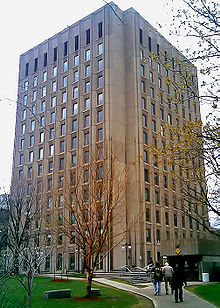McGill Atmospheric and Oceanic Sciences

The departement is inside Burnside Hall
|
|
| Type | Public department |
|---|---|
| Established | 1959 |
|
Academic staff
|
11 Faculty and 6 Associate Faculty |
| Affiliations | McGill |
The Department of Atmospheric and Oceanic Sciences of McGill University is the largest university atmospheric-oceanic sciences group in Canada. In 2012, it has 11 Faculty and 6 Associate Faculty members, 5 support staff, 14 research associates and postdoctoral fellows, and 31 graduate students. It is known worldwide, in particular for weather radar research and Arctic studies. It has operated the second oldest weather observatory in Canada since 1862.
Since 1840, Charles Smallwood, a medical doctor and avid amateur meteorologist, was taking daily weather reports at his house in the village of Saint-Martin on Île Jésus (now Laval a suburb of Montreal). He was named "honorary professor" in Meteorology at McGill University in 1856, and at his suggestion, the first McGill Weather Observatory was established in 1862. The first instruments were donated by Smallwood et he was the first director of the Observatory. Since then, there is regular measurement of meteorological variables taken on University grounds, one of the longest record in Canada.
After the death of Smallwood in 1873, the position of professor in Meteorology was not filled for 88 years. However, the director of the Observatory was, and the second to occupy this post was the engineer C. H. McLeod, an assistant to Smallwood since his university days. McLeod began his term while Canada was setting up a Meteorological Service. He was instrumental to its development and to research on the subject by McGill. Professors of the McGill's Physics department began to work on meteorological projects and later, professors from Geography did too.
Following the Second World War, two active atmospheric research groups emerged at McGill. Dr J. Stewart Marshall and R.H. Douglas led a radar meteorology group (Stormy Weather Group) in the Physics Department, and Dr F. Kenneth Hare directed an arctic meteorology program in Geography. These two groups united in 1959 to form the Department of Meteorology. In 1986, McGill University formed the first Canadian group of research on climate with the National Research Council of Canada (CNRC). Four years later, the mandate was widened, and its staffing enlarged. It is now the Centre for Climate and Global Change Research (C2GCR). The department started the Centre for research in mesoscale meteorology, in collaboration with the Meteorological Service of Canada, and it operates J. S. Marshall Radar Observatory since 1968.
...
Wikipedia
